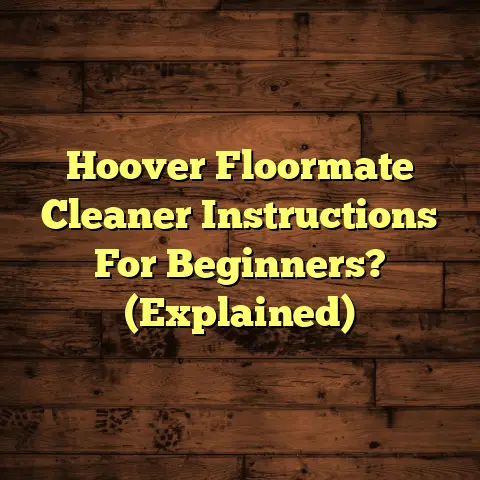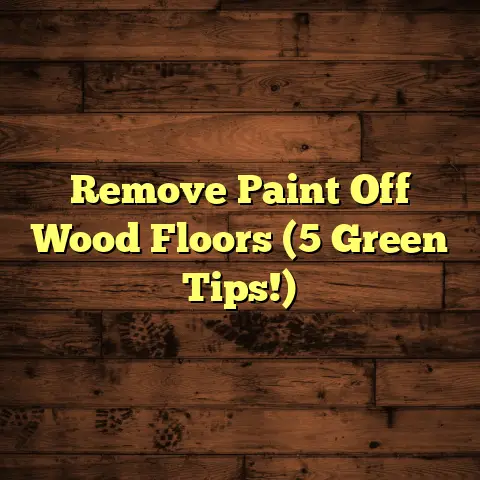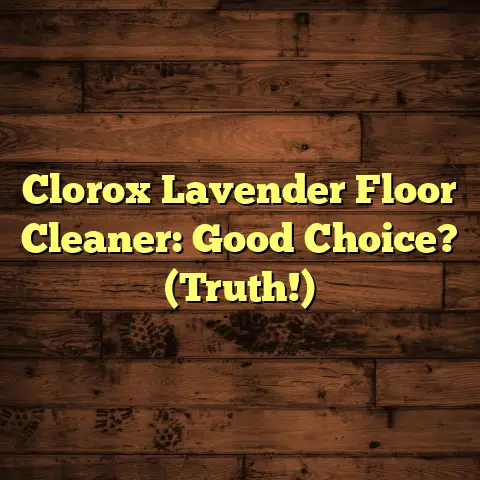Clean & Shine Hardwood Floors (3 Dullness Disaster Tips!)
And let me tell you, I’ve seen it all when it comes to hardwood floors.
From the gloriously gleaming to the sadly lackluster.
Hardwood floors, right? They’re like the little black dress of interior design.
They just work.
Contemporary, traditional, rustic, eclectic – you name it, hardwood seamlessly blends, adding warmth and sophistication.
Think about those sun-drenched mornings in a modern loft, or the cozy evenings by the fire in a traditional home.
Hardwood floors are the unsung heroes, quietly enhancing the ambiance and boosting your home’s value.
But here’s the thing: that natural beauty doesn’t just happen.
It needs a little TLC.
And that’s where I come in.
I’m here to help you avoid the dreaded dullness disaster and keep your hardwood floors looking their absolute best.
Trust me, it’s not as daunting as it seems.
Section 1: Understanding Hardwood Floor Dullness
So, what exactly causes that gorgeous sheen to fade?
Why do hardwood floors lose their luster over time?
Well, it’s a combination of factors, really.
Think of it like this: your floors are constantly under attack!
Foot traffic is a big one.
Every step grinds tiny particles of dirt and grit into the finish, creating microscopic scratches that dull the surface.
It’s like sandpaper, but on a much smaller scale.
Sunlight exposure is another culprit.
UV rays can break down the finish, causing it to fade and yellow.
Ever notice how rugs leave a darker patch when you move them?
That’s the sun at work.
And then there’s humidity.
Too much moisture can cause wood to swell and warp, while too little can lead to cracking and splitting.
Both extremes can damage the finish and contribute to dullness.
But perhaps the biggest offender?
Improper cleaning products and methods.
Using the wrong cleaner can strip the finish, leaving your floors vulnerable to damage.
Harsh chemicals can eat away at the protective layer, making your floors look dull and lifeless.
I’ve seen homeowners unknowingly ruin their floors with well-intentioned but misguided cleaning efforts.
Don’t let that be you!
Section 2: Tip #1 – Choosing the Right Cleaning Products
Okay, so now we know what causes dullness.
The next question is: how do we fight back?
It all starts with choosing the right cleaning products.
Think of your hardwood floors as a delicate ecosystem.
You wouldn’t pour toxic chemicals into a fish tank, right?
Same principle applies here.
Using the wrong cleaner can have disastrous consequences.
Avoid common household products like vinegar and ammonia.
While they might seem like effective cleaners, they’re actually quite harmful to hardwood finishes.
Vinegar is acidic and can etch the finish, while ammonia is alkaline and can strip away the protective layer.
I’ve seen floors with permanent haze after using vinegar.
It’s a sad sight, believe me!
Instead, look for cleaning solutions specifically designed for hardwood floors.
These products are formulated to be gentle yet effective, cleaning without damaging the finish.
They often have a neutral pH and contain ingredients that help to protect and enhance the shine.
Here are some keywords to look for on the label:
- “Hardwood Floor Cleaner”
- “pH Neutral”
- “Safe for Wood Floors”
Eco-friendly cleaning alternatives are also a great option.
Many companies now offer plant-based cleaners that are just as effective as traditional products, but without the harsh chemicals.
Look for brands that are certified by organizations like the Environmental Protection Agency (EPA).
Here are a few of my go-to eco-friendly options:
- Bona Hardwood Floor Cleaner: This is a classic for a reason.
It’s pH neutral, water-based, and GREENGUARD GOLD certified. - Method Squirt + Mop Hardwood Floor Cleaner:
Another great option, especially if you prefer a spray mop.
It’s biodegradable and made with plant-based ingredients. - Better Life Naturally Dirt-Destroying Floor Cleaner:
This one is tough on dirt but gentle on your floors.
It’s plant-derived and free of harsh chemicals.
Pro Tip: Always test a new cleaner in an inconspicuous area before applying it to the entire floor.
This will help you ensure that it doesn’t damage the finish.
Section 3: Tip #2 – Mastering the Cleaning Technique
Choosing the right cleaner is only half the battle.
You also need to master the proper cleaning technique.
Think of it like painting a masterpiece.
You wouldn’t just slap the paint on any old way, right?
You’d use the right brush, the right technique, and the right amount of paint to achieve the desired result.
The same goes for cleaning hardwood floors.
The key is to avoid streaks and dullness.
And that starts with using the right tools.
Ditch the traditional mop!
Those stringy mops tend to push dirt around rather than actually removing it.
Plus, they can leave behind excess water, which can damage your floors.
Instead, opt for a microfiber mop.
Microfiber mops are made of tiny, absorbent fibers that trap dirt and grime.
They’re also much gentler on the finish than traditional mops.
I personally prefer the flat microfiber mops.
They cover more surface area and are easier to maneuver.
Now, let’s talk about application.
Less is more!
You don’t need to soak your floors to get them clean.
In fact, too much water can be detrimental.
Excess water can seep into the seams between the boards, causing them to swell and warp.
Apply the cleaning solution sparingly.
I recommend using a spray bottle to mist the floor lightly.
Then, use the microfiber mop to wipe the floor in the direction of the wood grain.
Avoid applying too much pressure.
Let the mop do the work.
Work in small sections.
This will help you ensure that you’re cleaning the entire floor evenly.
Rinse the mop pad frequently.
This will prevent you from spreading dirt around.
The drying process is also important.
You want to dry the floor as quickly as possible to prevent water damage.
Open windows and doors to improve ventilation.
You can also use a fan to speed up the drying process.
Pro Tip: If you spill something on your hardwood floor, clean it up immediately.
The longer it sits, the more likely it is to stain or damage the finish.
Section 4: Tip #3 – Regular Maintenance and Protection
Okay, so you’re using the right cleaner and the right technique.
But what about the long game?
How do you keep your hardwood floors shiny and protected for years to come?
The answer is regular maintenance and protection.
Think of it like brushing your teeth.
You wouldn’t just brush them once a week, right?
You’d brush them every day to keep them healthy and clean.
The same goes for your hardwood floors.
Regular dusting and sweeping are essential for removing dirt and debris that can scratch the finish.
I recommend dusting or sweeping at least once a week, or more often if you have pets or children.
Periodic deep cleaning is also important.
This involves using a hardwood floor cleaner to remove built-up dirt and grime.
I recommend deep cleaning your floors every few months, or as needed.
Protective measures can also go a long way in preventing scratches and wear.
Area rugs are a great way to protect high-traffic areas, such as hallways and living rooms.
They also add warmth and style to your home.
Furniture pads are another must-have.
Place them under the legs of your furniture to prevent scratches and dents.
Reapplying finish or polish at recommended intervals can also help to restore shine and protect your floors.
The frequency of reapplication will depend on the type of finish and the amount of traffic your floors receive.
Pro Tip: Consider investing in a good-quality floor mat for your entryway.
This will help to trap dirt and debris before it gets tracked onto your hardwood floors.
Here’s a quick maintenance schedule I recommend:
Understanding Your Finish:
It’s crucial to know what type of finish is on your floor.
Common types include:
- Surface Finishes (Polyurethane, Acrylic): These form a
protective layer on top of the wood.
They’re durable and relatively easy to maintain. - Penetrating Finishes (Oil-Based, Wax): These soak into
the wood fibers and provide a more natural look.
They require more frequent maintenance.
Consult a professional!
If you’re unsure about any aspect of hardwood floor care, don’t hesitate to consult a professional flooring contractor.
We can assess your floors, recommend the best cleaning products and methods, and even reapply the finish if necessary.
Conclusion
So, there you have it: my top three tips for keeping your hardwood floors clean and shiny.
It’s not just about aesthetics, though.
It’s also about prolonging the lifespan of your floors and enhancing the overall value of your home.
By implementing these tips, you can enjoy the beauty of your hardwood floors for years to come.
Remember:
- Choose the right cleaning products.
- Master the cleaning technique.
- Maintain and protect your floors regularly.
With a little effort, you can avoid the dullness disaster and keep your hardwood floors looking their absolute best.
Call to Action
Now, I want to hear from you!
What are your favorite tips and tricks for maintaining hardwood floors?
Share your experiences and insights in the comments section below.
Let’s build a community of shared knowledge and support.
Happy cleaning!





